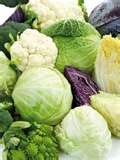Many Christians are in the midst of crucifying their flesh, observing Lent by sacrificing their normal indulgences in honor of Jesus, the one crucified so we might live. But what happens after Lent? What happens after any season of fasting, of giving up anything that has kept us from thriving? Many of us go back to our normal routines and pick back up the normal consequences, like weight gain, a blotched complexion and other maladies from poor eating. But if you regularly incorporate cruciferous vegetables into your diet, you will see a huge difference in your digestion and complexion.
Cruciferous literally means “cross-shaped” and refers to “a group of vegetables—including broccoli, Brussels sprouts, cabbage, cauliflower, turnips, and rutabagas—that have characteristic cross-shaped blossoms and that contain substances that may help to prevent colon cancer.”* Collard and mustard greens are also in this family. Dr. Don Colbert in Toxic Relief says these vegetables contain powerful phytonutrients (plant nutrients) that help the liver detoxify chemicals and drugs. They are best eaten raw or steamed. I know those of you who like to boil all the bright color out of your greens don’t want to hear about eating them raw or steamed so here are some things I do with my cruciferous vegetables instead of boiling them:
Juice them
You have to play with the combinations or you’ll think you are eating dirt (I had plenty of falls and ate mud pies when I was a child so I do know what dirt tastes like). Make sure you add an apple to help sweeten your combination.
Soup them
When you juice these vegetables add a clove or two of garlic with it then warm it up (but don’t boil it). You’ll have a nice tasty soup.
Stir-Fry them
Use a little Extra-virgin olive oil on low to medium heat (this oil can’t stand up to high temperatures) to first sauté some onions and maybe some bell peppers and then add any or a mixture of the vegetables with whatever seasoning you wish. I usually only add a little salt and pepper because the onions and oil give the vegetables a good flavor.
Stir-Fry and Steam them
For my greens and cabbage, I first sauté some fresh onions, garlic and a small de-seeded jalapeño pepper in some olive oil. Then I add the vegetables with my seasonings and cover the pot, which releases the water from the vegetables and steams them. You must use a non-stick sauce pan or your food will burn.
Just like Jesus died so we might live, let’s eat the cruciferous vegetables He put on earth so we might live vibrant lives. When you know better so you got to do better.
Copyright 2011 by Rhonda J. Smith
*Prescription for Nutritional Healing, 3rd Edition, by Phyllis A. Balch, CNC and James F. Balch, M.D.



